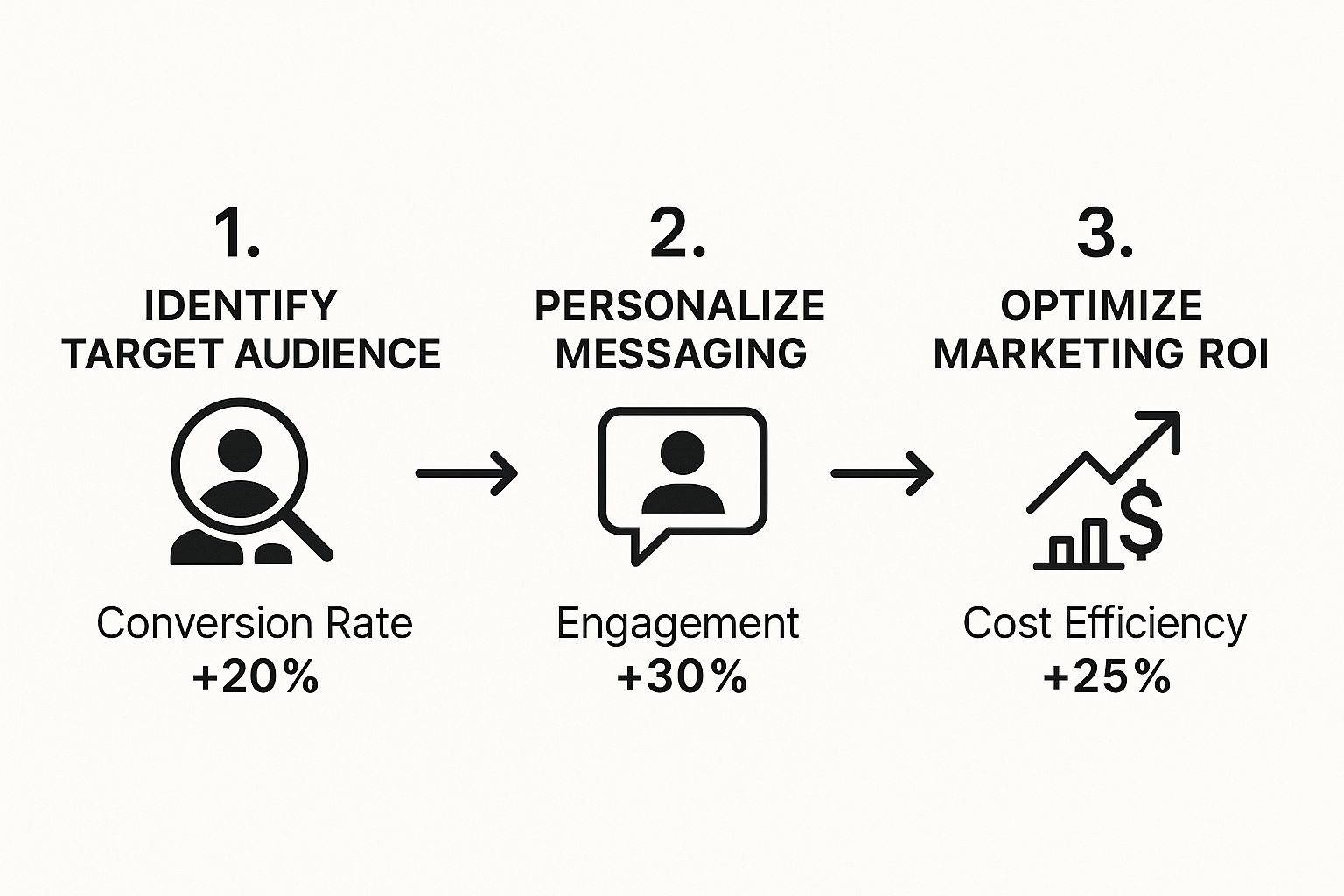Let's be honest, most buyer personas are just glorified PDFs collecting digital dust somewhere on a shared drive. This isn't just a missed opportunity; it's a mistake that actively costs you sales. A well-researched, data-driven buyer persona isn't just a document—it's one of the most critical assets in your sales toolkit, capable of directly improving your outreach and boosting your bottom line.
Why Generic Personas Don’t Drive Sales

Too many sales teams still operate with vague, assumption-based profiles like "Marketing Mary" or "Startup Steve." These personas are often built on clichés and gut feelings, not hard evidence. They describe a caricature, not a real customer.
When your personas are built this way, they fail to provide the specific insights needed for outreach that actually connects. Your team ends up sending generic messages that don't land because they don't address real pain points, goals, or day-to-day job responsibilities. The result? Abysmal engagement, ignored emails, and a sales cycle that drags on forever.
The Real Cost of Vague Profiles
Moving beyond these tired templates isn't some fluffy marketing exercise. It’s a strategic business decision with a clear and measurable return on investment. When you have a deep, evidence-based understanding of your ideal customer, it sharpens every single stage of the sales process.
Think about the tangible benefits. Research from a McKinsey & Company survey highlights that a data-driven approach can slash customer acquisition costs by up to 50%, lift revenues by 5% to 15%, and boost marketing ROI by a staggering 10% to 30%. It’s a powerful reminder of how data keeps personas relevant and impactful, as detailed on Agility.com.
A persona built on real data tells you why a prospect needs your solution, not just who they are. This shift from demographics to motivations is the key to unlocking meaningful conversations and closing more deals.
The Financial Impact of Data-Driven vs Generic Personas
The difference between a generic and a data-driven persona is stark. One leads to wasted effort and frustrated reps, while the other creates a powerful competitive edge. Let's look at how the outcomes stack up.
| Metric | Generic Persona (Assumption-Based) | Data-Driven Persona (Evidence-Based) |
|---|---|---|
| Outreach Strategy | "Spray and pray" mass messaging | Highly targeted, personalized sequences |
| Sales Cycle Length | Longer; multiple follow-ups needed | Shorter; addresses needs from the first touch |
| Message Resonance | Low open and reply rates | High engagement and positive replies |
| Team Confidence | Low; reps struggle to connect | High; reps have clear talking points |
| Sales Efficiency | Low; time wasted on poor-fit leads | High; focus on high-potential prospects |
Ultimately, investing the time to build a buyer persona grounded in real-world data is one of the highest-leverage activities for your sales strategy. It provides the clarity your team needs to stop guessing and start selling with precision. By moving from vague descriptions to vivid, actionable profiles, you empower your team to build trust, shorten sales cycles, and consistently hit their targets.
Gathering Intelligence for Authentic Personas
Let's be honest: buyer personas built on assumptions are useless. To create a persona that actually helps you sell, you need to put on your detective hat. The goal is to dig for the real-world clues that reveal your customer's reality—not just who they are, but what their world looks like. We're moving beyond basic demographics to really understand them.
The best place to start? Direct conversations. Talk to your happiest customers, the ones who truly get the value you provide. Don't just ask what they like about your product. Ask them about their day, their biggest frustrations at work, and the KPIs that keep their boss happy. This is where you strike gold.
This is all about building a clear picture of your audience, which, as you can see below, is the first step toward better messaging and a much stronger ROI.

When you know who you're talking to, everything from engagement to cost efficiency starts to improve significantly.
Uncover Insights from Your Internal Teams
Think of your customer-facing teams as a living, breathing database of persona intelligence. Your sales reps and customer support specialists are on the front lines every single day. They hear the unfiltered stories, objections, and pain points straight from the source.
You need a simple way to tap into this. It doesn't have to be complicated. Set up a dedicated Slack channel, a quick weekly huddle, or even just a shared doc where reps can drop quotes, common questions, and observations. These aren't just anecdotes; they're patterns waiting to be discovered.
For instance, if multiple reps mention that prospects keep bringing up Competitor X's "one cool feature," that's a massive clue. It tells you about their evaluation process and what they're paying attention to in the market. This is the kind of real-world feedback you can't get anywhere else.
Mine Your Existing Data for Clues
Beyond conversations, your own tech stack is packed with behavioral clues. You just have to know where to look. Your CRM, for example, isn't just a list of contacts—it's a goldmine of interaction history that can reveal powerful trends.
Here are a few places I always check:
- CRM Data: Look for patterns in job titles, company sizes, and industries among your best deals. Which lead sources consistently deliver the highest value? This hard data helps validate what you're hearing in interviews.
- Support Tickets: The language people use in support tickets is incredibly revealing. What are the most frequent issues? These tickets expose user frustrations and day-to-day challenges with raw clarity.
- Website Analytics: Which blog posts or landing pages do your best prospects visit right before they book a demo? This shows you exactly what information they find most valuable during their research.
- Social Media: Lurk on platforms like LinkedIn. See what people with your target job title are talking about in industry groups. What questions are they asking? It’s a candid look into their professional world.
The real magic happens when you synthesize all these streams. When a theme from a customer interview is echoed by trends in your CRM and support tickets, you can be confident you’ve uncovered a core truth about your persona.
Expand Your Research with Targeted Surveys
Internal data is a great start, but sometimes you have specific knowledge gaps you need to fill. That's where targeted surveys come in handy. And I'm not talking about those generic, mass-emailed questionnaires that everyone ignores.
Modern tools allow for much smarter approaches. For example, using methods like granular targeting with in-app surveys can give you incredibly deep insights into user behavior right when it matters most, which is crucial for building accurate personas.
Imagine you want to know what triggers a prospect to start looking for a solution like yours. You could deploy a short, one-question poll on your website that only appears to visitors who fit a certain profile. Or, send a brief survey to a segment of your email list that's shown interest but hasn't pulled the trigger.
The key is to keep them short and to the point. Instead of asking 20 questions, ask the three most important ones. The more focused you are, the higher your response rate will be and the more actionable your data.
Building a B2B Persona That Sales Can Use

Alright, you've done the digging and gathered some incredible intel. Now it's time to assemble the puzzle. The real goal here is to create a buyer persona that’s more than just a character sketch. We want to build a practical tool your sales team can actually lean on for their daily outreach and strategy.
A truly useful persona isn't just about demographics. It's about context. It should tell your reps not just who they're talking to, but what their world actually looks like. This is how you build real rapport and show value right from the first "hello."
What Do They Actually Do All Day?
First things first, let's outline what your persona does from 9 to 5. And I mean beyond their official job title. What are their core, day-to-day tasks? Are they constantly jumping between meetings, trying to manage a team, or are they buried deep in spreadsheets and reports?
Knowing this lets your sales team frame your solution in a way that feels immediately relevant. Instead of a generic pitch, they can say something like, "I know you're probably juggling team performance reviews and pipeline forecasting, and our tool can automate a chunk of that for you." It's a small shift, but it shows you get it.
Uncover Their Goals and KPIs
Next up, what does a "win" look like for this person? What are their professional goals? Even more importantly, what are the specific Key Performance Indicators (KPIs) their boss is grading them on?
These metrics are your sales team's secret weapon. A persona’s goal might be a bit vague, like "increase team efficiency." But their KPIs are concrete and measurable, like "reduce customer churn by 5%" or "book 15% more outbound meetings." When your reps know these numbers, they can tie your product's value directly to the metrics that keep your prospect up at night.
A persona's frustrations are usually the flip side of their goals. If their goal is hitting a revenue target, their frustration is whatever's stopping them—a leaky sales funnel, bad leads, you name it. This is where your solution gets to be the hero.
Map the Decision-Making Landscape
In B2B, you almost never sell to a single person. Your persona is part of a complex web of influencers, blockers, budget holders, and end-users. You have to map this out.
Start asking these critical questions:
- Who do they report to? This person is often a key stakeholder or the ultimate economic buyer.
- Do they manage a team? Their direct reports can become powerful internal champions if your tool makes their lives easier.
- Which other departments do they work with? Think Legal, Finance, or IT. Knowing these relationships helps you anticipate roadblocks later in the sales cycle.
- Where do they get their info? Pinpoint the specific blogs, podcasts, influencers, or industry groups they follow. These are their "watering holes"—the perfect places to engage and build authority.
This kind of mapping helps your team navigate the internal politics of a target company. It turns your persona from an isolated individual into a key player within their organization. These insights are also pure gold for your B2B sales lead generation efforts, as you can start targeting multiple influential people at the same account.
A Real-World Persona Example in Action
Let's pull it all together. Say you're creating a persona for a VP of Sales at a SaaS company. Instead of just "Sales Manager Sam," you build out a profile that's actually useful.
Persona Profile: "Focused Fiona," VP of Sales
| Category | Details |
|---|---|
| Job Role | VP of Sales at a mid-market tech company (250-500 employees). Manages a team of 15-20 Account Executives. |
| Responsibilities | Weekly pipeline reviews, 1-on-1 coaching, sales forecasting, reporting to the CRO, and hiring new reps. |
| Primary Goals | Meet quarterly revenue targets. Improve sales team efficiency and reduce ramp time for new hires. |
| KPIs | Quota attainment (team-wide), sales cycle length, and lead-to-close conversion rate. |
| Frustrations | Reps wasting time on manual outreach and poor-fit leads. Lack of visibility into what messaging actually works. |
| Watering Holes | Follows "SaaStr" and "Gong Labs" blogs. Listens to the "30 Minutes to President's Club" podcast. |
| Decision-Makers | Reports to the Chief Revenue Officer (CRO). Needs budget approval from the CFO for purchases over $25,000. |
See the difference? With this level of detail, your sales reps are armed with specific talking points that will actually resonate. To nail down the right companies in the first place, it's a great idea to use an Ideal Customer Profile (ICP) template to define the company-level details before you dive into individual roles. This layered approach ensures you're targeting the perfect company and the perfect person inside it.
Putting Your Personas to Work in Your Sales Outreach
Let's be honest. A beautifully crafted buyer persona is just a pretty document until you actually use it. Its real power only kicks in when it starts shaping your day-to-day sales activities, turning generic, spammy outreach into conversations that actually resonate. This is where the rubber meets the road—the bridge between all that research and actual revenue.
"Activating" a persona just means translating its core elements—pain points, goals, how they like to communicate—into the very DNA of your outreach. It’s about more than just dropping a name into a template. It's a fundamental shift in the angle and substance of your messaging across every single channel.
Tailoring Your Email Sequences
Email is still a beast in B2B outreach, but let's face it, inboxes are a warzone. This is where your persona gives you an immediate edge. Instead of leading with your product, you lead with their problem.
Let’s take "Focused Fiona," our VP of Sales persona. We know her biggest headache is her reps getting bogged down in manual, time-wasting tasks. A generic email might just say, "Our tool automates sales outreach." Yawn.
A persona-driven email, on the other hand, sounds like this:
Subject: Saving your AEs 5 hours/week
Hi Fiona,
I saw your team is growing, and I know that VPs of Sales are often challenged with keeping new reps focused on selling instead of manual data entry.
Our platform helps cut down on prospecting time so your team can focus on what matters—closing deals and hitting quota.
See the difference? This message speaks directly to her known challenges and connects your solution to her specific KPIs. The impact is huge. We've seen research showing that using buyer personas can boost email open rates by two to five times. Why? Because the message is built for the person receiving it.
Crafting Compelling LinkedIn Outreach
LinkedIn is an incredible channel, but it's also drowning in robotic connection requests. Your persona helps you cut through that noise by making your outreach personal and valuable from the very first touch.
A great way to do this is by using your persona's "watering holes"—the influencers they follow, the groups they're in—to establish some common ground. It's a simple, human way to connect.
- Reference Shared Content: "Hi Fiona, I saw you also follow Gong Labs. Their latest post on discovery calls was spot-on. I'm reaching out because we help sales leaders like you implement similar data-driven coaching methods."
- Acknowledge Their Role: "Hi Fiona, as a fellow sales leader, I was impressed by your company's recent growth. I imagine scaling the sales team while maintaining efficiency is a top priority."
These aren't grand gestures, just small, personalized details that show you've done your homework. They signal that you're a peer who understands their world, not just another spammer blasting out messages. This whole approach is about finding ways to personalize your sales outreach at scale, so you can be efficient without losing that crucial human touch.
Making Cold Calls Warmer
Even the dreaded cold call feels warmer when it's guided by a solid persona. Before you even think about picking up the phone, do a quick review of the persona's key goals and frustrations. This gives you a crystal-clear "reason for calling" that isn't just about you and your product.
Instead of the classic, "Do you have 15 minutes to hear about our platform?" try an opener that's rooted in their world:
"Hi Fiona, my name is [Your Name] from [Your Company]. I'm calling because we work with other VPs of Sales in the SaaS space who are struggling to reduce ramp time for new hires. Is that something on your radar right now?"
This opener immediately validates their role and brings up a highly relevant, painful industry challenge. It instantly pivots the conversation from a sales pitch to a problem-solving discussion. If you want to take this a step further, you can even explore ways to automate outbound calls for better sales results, helping you scale these personalized touchpoints.
Ultimately, by activating your persona, every single interaction becomes a genuine opportunity to build trust and show you’re there to help, not just to sell.
Keeping Your Buyer Personas Fresh and Relevant
Markets shift. Customer priorities evolve. New tech pops up. The buyer persona you painstakingly crafted just six months ago might already be missing critical pieces of the puzzle.
A persona isn't a static document you create once and frame on the wall. It’s a living, breathing tool that needs regular maintenance to stay sharp.
Letting your personas gather digital dust is a surefire way to let your outreach become stale and irrelevant. To stop that from happening, you need a simple, repeatable process for keeping them fresh. This ensures your sales team is always working with the most accurate and powerful insights available.
Establish a Regular Review Cadence
First things first, get it on the calendar. A persona check-in shouldn't be an afterthought; it needs to be part of your operational rhythm. For most B2B companies, a quarterly review is a great starting point.
This doesn't have to be a huge, formal affair. Just get your sales and marketing leads in a room for an hour. The goal is to compare notes and answer one simple question: "What has changed about our buyers in the last 90 days?"
Here’s a quick checklist for that quarterly sync-up:
- Sales Team Feedback: What new objections are reps hearing on calls? Are different pain points surfacing during discovery?
- New Customer Data: Look at the deals you've won recently. Do you see any new patterns in job titles, industries, or company sizes?
- Marketing & Engagement Data: Is a new type of content suddenly taking off? What insights can you pull from your most successful campaigns? Digging into your 5 lead generation strategies and tips can uncover some real gems here.
This image from Agility PR really drives home how continuous data input is the antidote to persona decay.
The big idea here is that constant data—from sales, marketing, and direct customer feedback—is what keeps your personas from becoming useless relics.
Think of your persona like a high-performance engine. It needs regular tune-ups to keep running at its peak. A simple quarterly check-in is that crucial maintenance, preventing major breakdowns in your sales and marketing alignment.
Watch for Immediate Review Triggers
Besides your scheduled reviews, some events should ring the alarm bell for an immediate persona huddle. These are the big market or business shifts that could fundamentally change your buyer's world overnight. Waiting until the next quarter could mean missing a huge opportunity or, worse, failing to see a new threat on the horizon.
Keep an eye out for these key trigger events:
- A new product or major feature launch: Your value proposition just changed. You need to understand how that impacts your persona's goals and challenges right now.
- A major shift in the competitive landscape: If a key competitor gets acquired, drops a groundbreaking feature, or goes out of business, your persona's evaluation criteria will change.
- Poor campaign performance: If your outreach metrics suddenly nosedive, it’s a huge red flag that your messaging isn't connecting anymore. It’s time to figure out why—fast.
- Entering a new market segment: You can't just assume your existing personas will work when you start targeting a new industry or company size. You absolutely must build a new buyer persona tailored to this specific audience.
By combining a regular review cadence with an awareness of these triggers, you build a robust system. This ensures your personas stay dynamic, accurate, and, most importantly, become a true asset that helps your sales team close more deals.
Common Persona Mistakes and How to Avoid Them

Even with the best of intentions, it’s surprisingly easy to veer off course when building buyer personas. Honestly, creating an effective profile is as much about dodging the common pitfalls as it is about following the right steps.
Knowing these mistakes upfront will make sure all that research you're about to do actually turns into a sales asset your team can use, not just a document that gathers dust.
One of the most common mistakes I see is creating way too many personas. It might feel like you're being thorough, but giving a small sales team ten different profiles just creates confusion and dilutes their focus. It's impossible to master outreach for that many different "people." What happens? Your team defaults back to generic messaging, and the whole exercise was for nothing.
The Dangers of Shallow Data
Another major trap is building personas based only on demographics. Sure, knowing a prospect's age, location, and job title is a start, but it tells you almost nothing about what actually drives them.
The real gold is in the psychographics—their goals, what frustrates them daily, and the pressures they're under. This is the ammunition your sales team needs to have a real, meaningful conversation. You have to know the why behind what they do. A persona without these motivational insights is just a flat character sketch, not a strategic tool.
The most dangerous mistake is treating persona creation as a one-and-done project. Markets change, priorities shift, and your buyer's challenges evolve. A persona that is not regularly updated becomes irrelevant and misleading.
This brings me to another critical error: building personas in a silo. When marketing cooks up profiles without getting deep input from the sales reps on the front lines, they miss a huge piece of the puzzle. Salespeople are the ones hearing the unfiltered objections and pain points every single day.
Without their perspective, your personas will always feel a bit… off. This disconnect leads to profiles that look great on paper but fall flat in an actual sales call.
Avoiding Bias and Building for Action
Finally, you have to be on guard against confirmation bias. This is our natural human tendency to look for data that supports what we already believe and ignore anything that contradicts it. It’s a subtle but damaging mistake that results in creating the persona you want to sell to, not the one that actually exists.
The best way to fight this? Actively try to prove yourself wrong. Ask questions that could poke holes in your assumptions.
To make sure your personas are powerful and genuinely useful, here's what to do:
- Limit your focus: Seriously, start with just one or two core personas. You can always add more later once you've nailed these.
- Integrate your teams: Make this a joint project between sales and marketing from day one. No silos.
- Prioritize motivations: Always dig deeper than demographics. Uncover their real goals and frustrations.
- Schedule regular reviews: Put a recurring quarterly persona review on the calendar. This keeps them fresh, relevant, and accurate.
By sidestepping these common blunders, you can be confident that the effort you're putting in will result in a tool that genuinely guides your team, sharpens your outreach, and drives real results for the business.
Of course. Here is the rewritten section, following the style and tone of the provided examples.
Answering Your Key Persona Questions
Whenever I talk to sales teams about building out their buyer personas, the same few questions always pop up. They're good questions, too—the kind that separates a theoretical exercise from a strategy that actually drives revenue.
Getting the answers straight from the beginning is what makes the difference. Let’s get into the three most common questions I hear.
How Many Personas Do We Actually Need?
This is the big one. And my answer is almost always, "Fewer than you think."
It's easy to get carried away and try to map out every single customer variation you've ever encountered. But that just creates noise. Your team can't possibly keep ten different personas straight, and the effort gets spread way too thin.
Honestly, it's so much more effective to have one to three incredibly detailed, practical personas than a dozen shallow ones.
For most B2B teams just starting out, picking one or two core personas is the sweet spot. It lets your reps truly nail the messaging for your most important customer segments. Get those right, see the results, and then you can think about adding more.
What’s the Difference Between a Persona and an ICP?
This one trips up a lot of people, but the distinction is critical. Your Ideal Customer Profile (ICP) and your buyer personas are related, but they do two very different jobs. You really need both to get a complete picture of who you're selling to.
Here’s how I break it down:
- Your ICP is the what. It’s a description of the perfect company you should be targeting. This is all about firmographics: industry, company size, annual revenue, where they're located, what tech they use. It answers, "Which accounts should we go after?"
- Your buyer persona is the who. This is a deep dive into the specific people inside those ideal companies. What’s their job title? What are they trying to accomplish? What keeps them up at night? Who do they need to convince to get a deal signed?
Your ICP helps you find the right playground. Your buyer personas tell you who to talk to once you're there.
You can't have one without the other if you want your outreach to be truly effective.
How Often Should We Update Our Personas?
This is so important: a buyer persona is not a "set it and forget it" document. Your market is always shifting, your customers' priorities change, and new challenges are constantly emerging. A persona you built a year ago might be a relic today, leading your team completely astray.
As a rule of thumb, you should formally review and refresh your personas at least once per year. But I’m a big fan of a quick, informal check-in with the sales team every quarter. That’s how you catch the subtle shifts before they become big problems.
There are also specific events that should trigger an immediate persona review:
- You're launching a major new product or feature.
- You're moving into a new industry or geographic market.
- A major competitor does something that shakes up the landscape.
- Your outreach and sales numbers start to dip for no obvious reason.
Think of your personas as living documents. Keep them sharp, and they'll remain one of the most powerful tools in your sales arsenal.
Ready to put these ideas into practice? Salesloop.io helps you segment your audience based on these detailed personas and launch targeted, multichannel campaigns that actually start conversations. Stop guessing and start connecting. Explore our plans and see how it works.





